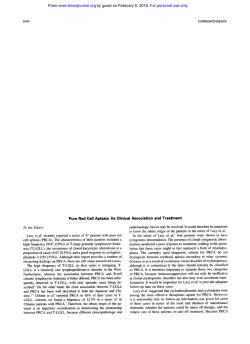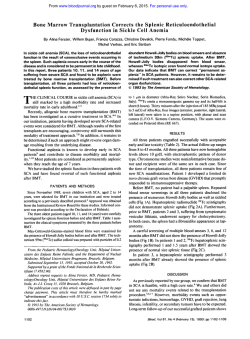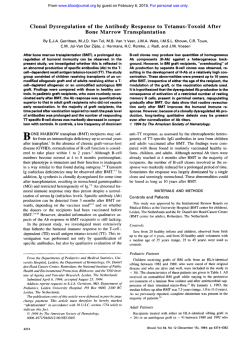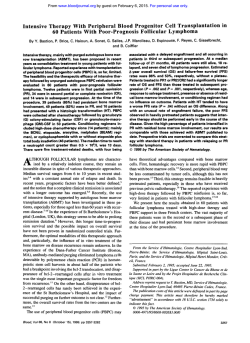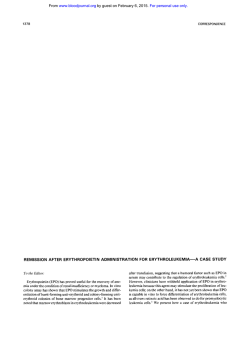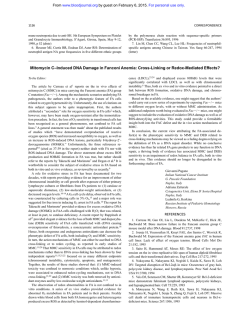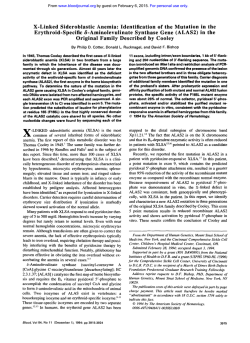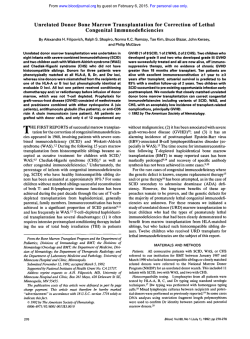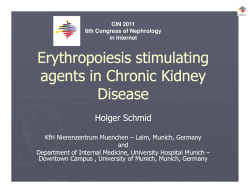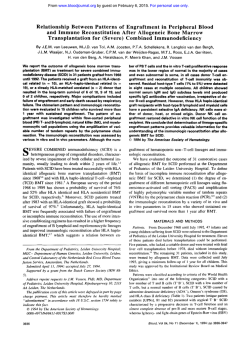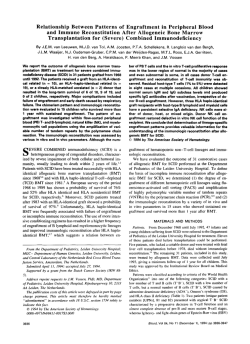
Complete Remission in Severe Aplastic Anemia
From www.bloodjournal.org by guest on February 6, 2015. For personal use only. Complete Remission in Severe Aplastic Anemia After High-Dose Cyclophosphamide Without Bone Marrow Transplantation By Robert A. Brodsky, Lyle L. Sensenbrenner, and Richard J. Jones Severe aplastic anemia (SAA) can be successfully treated with allogeneic bone marrow transplantation (BMT) or immunosuppressivetherapy.However, themajority of patients with SAA are not eligible for BMT because they lack an HLA-identicalsibling. Conventional immunosuppressive therapy also has major limitations; many of its remissions are incomplete and relapse or secondary clonal disease is common. Cyclophosphamide is a potent immunosuppressive agent that is used in all BMT conditioning regimens for patients with SAA. Preliminary evidence suggestedthat high-dose cyclophosphamide, even without BMT, may be beneficial t o patients with SAA. Therefore, 10 patients with SAA and lacking an HLA-identical sibling were treated with high-dosecyclophosphamide(45mg/kg/d) for4 consecutive days with or without cyclosporine. A complete response (hemoglobin level, > l 3 g/dL; absolute neutrophil count, >1.5 x 109/L, and platelet count > 125 x 109/L)was achieved in 7 of the 10 patients. One of the complete responders died from the acquired immunodeficiency syndrome 44 months after treatment with high-dosecyclophosphamide.The 6 remaining patients are alive and in continuous complete remission, with a median follow-up of 10.8 years (range. 7.3 to 17.8 years). The mediantime t o last platelet transfusion and time to 0.5 x lo9 neutrophils/L were 85 and 95 days, respectively. None of the complete responders has relapsed or developed a clonal disease. These results suggest that high-dose cyclophosphamide, even without BMT. may be more effective than conventional immunosuppressive therapy in restoring normal hematopoiesis and preventing relapse or secondary clonal disorders. Hence, further studies confirming the efficacy of this approach in SAA are indicated. 0 7 9 9 6 b y The American Society of Hematology. A for this study if they lacked an HLA-identical donor. No patient was excluded from the study. However, between 1980 and1984. all patients with SAA and without an HLA-identical donor were entered on studies of either ALG followed by haploidentical BMT and androgens (15 patients)- or ATG alone (5 patients).I2These patients have been previously r e p ~ r t e d . ’ ~The , * ~last patient accrued to this study was treated at Wayne State University. SAAwas diagnosed by standard criteria2*:less than 25% marrow cellularity and depression in two of three blood counts (reticulocytes, <40 X 10y/L;platelets, c 2 0 X 109/L;and an ANC <0.5 X 10y/L).Aplastic anemia was considered super severe if it met the criteria for severe disease and the ANC was less than 0.2 X I O Y L All patients gave informed consent for study participation approved by the institutional review boards of Johns Hopkins University and Wayne State University. Treatment schedule. After confirmation ofthe diagnosis, patients were randomized to receive cyclophosphamide at 45 mg/kg/d intravenously (IV) on days 1 through 4, with or without cyclosporine. Patients randomized to receive cyclosporine received 5 mg/kg IV on days 4 through 9, 3.75 mg/kg/d IV on days 10 through 20, 2.5 mg/kg/d IV on days 21 through 27, and on days 28 through 32 both 1.5 mg/kg/d 1V and 5 mgkgld orally. The patients then received cyclosporine at 10 mgkgld orally on days 33 through 56 and 7.5 mg/kg/d orally from days 57 through 100, after which the drug was discontinued. All patients received only one course of therapy. Response. A complete response required normalization of all blood counts (ie, hemoglobin level, > 13 g/L; ANC > 1.5 X 10y/L; and platelet count, > 125 X 10y/L).All others were classified as CQUIRED SEVERE aplastic anemia (SAA) is a rare hematopoietic disorder that can be successfully treated by bone marrow transplantation (BMT) or immunosuppressive therapy.’ BMT leads to complete hematopoietic recovery and cure of the disease in 60%to 80% of patients, with the major causes of failure being graft rejection and graftversus-host disease.’” However, the majority of patients with SAA are not candidates for BMT because they lack an HLAidentical sibling. The majority (60%to 80%)of SAA patients treated with immunosuppression recover hematopoiesis sufficiently to be transfusion-independent and free of infection, although often not to completely normal blood counts.8“‘ The combination of antithymocyte globulin (or antilymphocyte globulin) and cyclosporine appears to be the most effective form of immunosuppressive Patients with super severe aplastic anemia (SSAA), ie, SAA patients with an absolute neutrophil count (ANC) of less than 0.2 X lo9/ L at diagnosis, have a poorer response to immunosuppression than do patients with just SAA.9,” A major limitation of immunosuppressive therapy is that up to 50% of successfully treated patients either relapse or develop late clonal diseases such as paroxysmal nocturnal hemoglobinuria (PNH), myelodysplastic syndrome (MDS), or acute Cyclophosphamide is a potent immunosuppressive agent and is used in all BMT conditioning regimens for patients with SAA. After preparation with cyclophosphamide, most allogeneic bone marrow grafts persist indefinitely; however, in several cases, complete autologous hematologic recovery has occurred.’’-’’ Case reports of 2 SAA patients achieving a complete hematologic remission with moderately highdose cyclophosphamide (40 to 120 m a g ) without BMT have also been des~ribed.’~.’~ These data suggest that cyclophosphamide, particularly in high doses, may be beneficial to patients with SAA even without allogeneic BMT. We treated 10 SAA patients lacking an HLA-identical sibling donor with high-dose cyclophosphamide. A complete hematologic remission was achieved in 7 patients, and, with a median follow-up of more than 10 years, no patient has relapsed or developed secondary clonal disease. MATERIALS AND METHODS Patients. Patients referred to the Johns Hopkins Oncology Center for the treatment of SAA between 1977 and 1986 were eligible Blood, Vol 87, No 2 (January 151, 1996 pp 491-494 From the Johns Hopkins Oncology Center, Johns Hopkins Medical Institutions, Baltimore, MD; andthe Division of Hematology and Oncology, Wayne State University School of Medicine, Detroit, MI. Submitted May 22, 1995; accepted September 1, 1995. SupPofled in part by National Institutes of Health Grant No. CA1.5396. R.J.J. is a Leukemia Sociezy of America Scholar. Address reprint requests to Richard J. Jones, MD, Johns Hopkins Oncology Center. Room 2-127, 600 N Wolfe St, Baltimore, MD 21287-8967. The publication costs of this article were defrayed in part by page charge payment. This article must therefore be hereby marked “advertisement” in accordance with 18 U.S.C. section 1734 solely to indicate this fact. 0 1996 by The American Society of Hematology. 0006-4971/96/8702-0027$3.00/0 49 1 3/F From www.bloodjournal.org by guest on February 6, 2015. For personal use only. JONES 492 BRODSKY, SENSENBRENNER, AND Table 1. Patient Characteristics Pretreatment Blood Counts Patient No. 1 2 3 4 5 6 7 8 9 10 ANC AgelSex 22/F 16/M 19/M 19/M 16/M 3O/F Retics CX~O~IL) 6 670 150 40 380 310 780 7/F 3WM 75 600 24/M 0 ( X 10"L) 18 6 2 15 14 PltS (x109ILl Etiology Previous Therapy 8 Benzene exposure Androgens/steroids None None None None None None Steroids None Androgenslsteroids 1 36 3 10 18 26 35 16 3 10 26 10 8 Idiopathic Idiopathic Benzene exposure Idiopathic Idiopathic Idiopathic Idiopathic Idiopathic Idiopathic Duration of SAA Before CY (wk) 52 4 2 2 3 16 4 40 3 8 Abbreviations: CY, cyclophosphamide; Retics, absolute reticulocyte count; Pits, platelet count, nonresponders. Persistence of a transfusion requirement was evidence of no response. RESULTS Patient characteristics are shown in Table 1; no patients were excluded from analysis. The median age (19 years; range, 7 to 38 years) was similar to that of other studies of SAA.7*'0,25 Of the 10 patients, 5 had SSAA and 5 had SAA. Most of the patients were newly diagnosed; the median duration of disease before treatment with high-dose cyclophosphamide was 1 month (range, 2 weeks to l year), and only 3 patients had received any prior therapy for their SAA. A complete response was achieved in 7 of the 10 patients; the majority of patients with both SAA (4/5)and SSAA (3/ 5) were complete responders (Table 1). An ANC of 0.5 X 109Lwas reached at a median of 95 days (range, 34 to 201 days), and the last platelet transfusion was at a median of 85 days (range, 35 to 151 days; Table 2). The use of cyclosporine did not appear to influence whether the patients were able to achieve a complete response, with 5 of 7 patients treatedwith cyclophosphamide alone and 2 of 3 patients treated with cyclophosphamide plus cyclosporine attaining a complete response. None of the 7 complete responders has relapsed or developed a clonal disease, with a median followupof 10.8 years (range, 7.3 to 17.8 years); 6 of the 7 are alive and remain incomplete remission with completely normal blood counts, and 1 patient became infected with the human immunodeficiency virus from a blood transfusion and died of acquired immunodeficiency syndrome (AIDS) 44 months after treatment (Table 2). Only 1 patient (in remission for > 10 years) has an elevated mean corpuscular volume (MCV; 105 pm3; normal range, 80 to 100 pm'), which has been reported to be predictive for the development of late clonal disorders in SAA patients treated with immunosuppre~sion.'~ Dysplastic changes in the remission bone marrows (especially in the monocytic and megakaryocytic lineages) may also be associated with the development of late clonal disorder^,'^ but were not present in any of the patients. High-dose cyclophosphamide was generally well-tolerated, with toxicities similar to those seen with autologous BMT. All acute side-effects resolved completely, with no evidence of late sequelae (although gonadal function has not been extensively evaluated). All patients developed febrile neutropenia requiring combinations of antibiotics. Transient Table 2. Hematologic Response to High-Dose Cyclophosphamide Days to Patient No. 1 2 3 4 5 6 7 8 9 10 Treatment (date1 Status CY ( M 7 ) CY (ID81 CY (8/78) CY (4184) CYICSA (7184) CYICSA (11/84) CY (2185) CYICSA W861 CY (5/86) CY (9187) CCR CCR295 NR CCR CR* CCR CCR NR NR CCR ANC of 500/pL 9513.8 20114.6 - Recent Blood Counts Last Plt WBC Transfusion (xlO9/L) (x103/L) 35 2.0 95 1.9 - 13.8 78 3.7 74 117 151 47 5.8 85 9613.8 135 2.6 167 5.7 5.9 - ANC MCVHgb (g/dL) 322 - - 7.2 4.2 5.4 - - - 3413.3 35 5.1 8.4 PltS (x103/L) 2.3 2.8 15.1 14.6 - - Date 99 98 - - 03/21/95 03/10/95 310 92 11111/94 140 166 182 1/87 94 105 46 - - 0511 03/08/95 07/13/94 202 99 12/22/94 - - - - Abbreviations: CY, cyclophosphamide; CSA, cyclosporine; CCR, continuous complete remission; NR, no response; Plt, platelet; WBC, white blood cell count; Hgb, hemoglobin. * Died of acquired immunodeficiency syndrome 44 months after treatment. From www.bloodjournal.org by guest on February 6, 2015. For personal use only. CYCLOPHOSPHAMIDE FOR APLASTIC ANEMIA 493 to an ANC of 0.5 x 109/L and transfusion-independence in this series (day 95 and 85, respectively) is comparable to that seen with conventional immunosuppression," even though no patient in our series received growth factor support. HLA-identical sibling BMT is currently the treatment of choice for young patients with SAA, primarily because of the lower risk of relapse and late clonal disorders when compared with patients treated with immunosuppression. Our data suggest that high-dose cyclophosphamide without BMT may also effectively restore normal hematopoiesis and prevent relapse or secondary clonal disorders. Although the beneficial effects of high-dose cyclophosphamide may just be a consequence of its intensive immunosuppressive activity, it is likely that the potent cytotoxic properties of cyclophosphamide are also important; this could have important DISCUSSION implications regarding the pathophysiology of SAA. It is not clear why aplastic anemia is a premalignant We found that high-dose cyclophosphamide without BMT Damage to hematopoietic stem cells may lead to an autoimproduced long-term survival and normal hematopoiesis in mune response directed against the bone marrow.28In addipatients with SAA. The response rate in our series is compation, sublethal damage to a stem cell may produce genetic rable with response rates seen after allogeneic BMT2-7or mutations that give it a growth advantage. Over time, an conventional immunosuppressive therapy with antithymoabnormal clone arising from a slowly proliferating, transcyte globulin and cyclosporine.8-l' A previous report sugformed stem cell could become dominant. Cyclophosphagested a lower response rate for SAA to cyclophosphamide." mide not only causes profound immunosuppression, but also However, most patients in the previous report received relahas the potential to destroy a minor population of damaged tively low doses of cyclophosphamide and the highest dose stem cells with the capacity to develop into MDS, P M , or was only two-thirds of the dose used in our study.*' acute leukemia. Like BMT, high-dose cyclophosphamide in our series proAlthough encouraging, these results remain preliminary. duced complete hematopoietic recovery in all responders and The studywas small and the patients were all relatively was notassociated with relapse or late clonal diseases despite young. Hence, further studies with high-dose cyclophosphaat least 7 years of follow-up in all patients. In contrast, mide need to be performed. Nevertheless, our data suggest conventional immunosuppressive therapy frequently fails to restore normal hematopoiesis and relapse is common.8.'03'1 that this approach should be considered as an alternative to immunosuppressive therapy in patients who lack an HLAFurthermore, conventional immunosuppressive therapy is identical sibling. also associated with a significant risk of late clonal diseases. Tichelli et a l l 7 reported a 42% cumulative risk of developing ACKNOWLEDGMENT PNH or MDS at 10 years after therapy with antilymphocyte We thank Marie C. Moineau for assistancein manuscript preparaglobulin. The European Group for Bone Marrow Transof Americaforhelp with tion,theAplasticAnemiaFoundation plantation (EBMT) reported an 18.8% cumulative incidence patientfollow-up, and DrsRobertStuart and MarkEdelsteinfor of cancer at 10 years after immunosuppressive therapy16; providing excellent patient care. however, theydidnot include PNH in their definition of malignancy. The EBMT previously reported that the inciREFERENCES dence of PNH after immunosuppresive therapy for S A A is 1. Young NS, Alter BP Pathophysiology 11: Immune suppression at least IO%.I4 The mean interval to the development of of hematopoiesis, in Young NS, Alter BP (eds): Aplastic Anemia PNH and MDS after immunosuppressive therapy is 3.0 and Acquired and Inherited. Philadelphia, PA, Saunders, 1994, p 68 4.6 years, re~pectively.'~ Recent studies using both antithy2. May WS, Sensenbrenner LL, Bums WH, Ambinder R, Carroll mocyte globulin and cyclosporine for the treatment of SAA MP, Jones RJ, Miller CB, Mellits ED, Vogelsang GB, Wagner J, report a lower incidence of late clonal diseases, but these Wingard J, Yeager AM, Santos GW: BMT for severe aplastic anemia studies still have a relatively short follow-up.8*'o," using cyclosporin. Bone Marrow Transplant 11:459, 1993 As with other forms of immunosuppression, some patients 3. Storb R, Deeg HJ, Farewell V, Doney K, Appelbaum F, Beatty P, Bensinger W, Buckner CD, Clift R, Hansen J, Hill R, Longton with SAA failed to respond to high-dose cyclophosphamide. G, Lum L, Martin P,McGuffin R, Sanders J, Singer J, Stewart P, This may result from a failure to abrogate immunologicSullivan K, Witherspoon R, Thomas ED: Marrow transplantation mediated hematopoietic suppression (analogous to graft reforsevereaplasticanemia:Methotrexatealonecompared with a jection after allogeneic BMT236*26) or a deficiency of normal combination of methotrexate and cyclosporineforprevention of host stem cells capable of reestablishing hematopoiesis. Alacute-graft-versus-host disease. Blood 69: 119, 1986 though high-dose cyclophosphamide may be somewhat more 4. McGlave PB, Haake R, Miller W, Kim T, Kersey J, Ramsey toxic than conventional immunosuppression, there were no NKC: Therapy of severe aplastic anemia in young adults and childeaths related to the procedure and all acute side-effects dren with allogeneic bone marrow transplantation. Blood 70:1325, were self-limited in this series. Moreover, the median time 1987 hepatitis, presumed to be viral in origin, developed in 4 patients; 2 patients experienced self-limited renal dysfunction, although 1 required short-term dialysis for a creatinine that reached a peak of 8.3 mg/dL. Hypertension requiring treatment developed in 2 patients who received cyclosporine, and transient congestive heart failure requiring diuretics OCcurred in 1 patient. No patient developed hemorrhagic cystitis. There were 3 patients whodidnot respond to therapy and subsequently died of their disease. One nonresponder recovered his ANC to greater than 0.5 X lo9& but died 31 months after treatment from an intracerebral hemorrhage. The 2 other deaths occurred within 6 months of therapy and were secondary to intracerebral hemorrhage and sepsis, respectively. From www.bloodjournal.org by guest on February 6, 2015. For personal use only. 494 5. Gluckman E, Horowitz MM, Champlin RE, Hows JM, Bacigalupo A, Biggs JC, Camitta BM, Gale RP, Gordon-Smith EC, Marmont AM, Masaoka T, Ramsay NKC, Rim AA, Rozman C, SoboM : Bone marrow transplantation for cinski KA, Speck B, Bortin M severe aplastic anemia: Influence of conditioning and graft-versushost disease prophylaxis regimens on outcome. Blood 79:269, 1992 6. Hows JM, Marsh JCW, Liu Yin J, Durrant S, Swirsky D, Worlsey A, Fairhead SM, Chipping PM, Palmer S, Gordon-Smith EC: Bone marrow transplantation for severe aplastic anaemia using cyclosporin: Long-term follow-up. Bone Marrow Transplant 4:11, 1989 7. Storb R, Etzioni R, Anasetti C, Appelbaum FR, Buckner CD, Bensinger W, Bryant E, Clift R, Deeg JH, Doney K, Flowers M, Hansen J, Martin P, Pepe M, Sale G, Sanders J, Singer J, Sullivan KM, Thomas ED, Witherspoon RP: Cyclophosphamide combined with antithymocyte globulin in preparation for allogeneic marrow transplants in patients with aplastic anemia. Blood 84:941, 1994 8. Frickhofen N, Kaltwasser JP, Schrezenmeier H, Raghavacher A, Vogt HG, Hermann F, Freund M, Meusers P, Salama A, Heimpel H: Treatment of aplastic anemia with antilymphocyte globulin and rnethlprednisolone with or without cyclosporine. N Engl J Med 324:1297, 1991 9. Gluckman E, Esperou-Bourdeau H, Baruchel A, Boogaerts M, Briere J, Donadio D, Leverger G, Leporrier M, Reiffers J, Janvier M, Michallet M, Stryckmans P, Cooperative Group on the Treatment of Aplastic Anemia: Multicenter randomized study comparing cyclosporine-A alone and antithymocyte globulin with prednisone for treatment of severe aplastic anemia. Blood 79:2540, 1992 10. Bacigalupo A, Broccia G, Corda G, Arcese W, Carotenuto M, Gallamini A, Locatelli F, Mori PG, Saracco P, Todeschini G, Coser P, Iacopino P, Van Lint MT, Gluckman E Antilymphocyte globulin, cyclosporin, and granulocyte colony-stimulating factor in patients with acquired severe aplastic anemia (SAA): A pilot study of the EMBT SAA Working Party. Blood 85:1348, 1995 I 1. Rosenfeld SJ, Kimball J, Vining D,YoungNS: Intensive immunosuppression with antithymocyte globulin and cyclosporin as treatment for severe aplastic anemia. Blood 85:3058, 1995 12. Young N, Griffith P, Brittain E, Elfenbein G, Gardner F, Huang A,HarmonD, Hewlett J, Fay J, Mangan K, MorrisonF, Sensenbrenner L, Shadduck R, Wang W, Zaroulis C, Zuckerman K A multicenter trial of antithymocyte globulin in aplastic anemia and related diseases. Blood 72: 1861, 1988 13. Speck B, Gratwohl A, Nissen C, Ostenvalder B, Wursch A, Tichelli A, Lori A, Reusser P, Jeannet M, Signer E: Treatment of severe aplastic anemia. Exp Hematol 14:126, 1986 14. de Planque MM, Bacigalupo A, Wursch A, Hows JM,Devergie A, Frickhofen N, Brand A, Nissen C : Long-term follow-up of severe aplastic anaemia patients treated with antithymocyte globulin. Br J Haematol 73:121, 1989 BRODSKY, SENSENBRENNER, AND JONES 15. Tichelli A, Gratwohl A, Wursch A, Nissen C , Speck B: Late haematological complications in severe aplastic anaemia. Br J Haematol 69:413, 1988 16. Socie G, Henry-Amar M, Bacigalupo A, Hows J, Tichelli A, Ljungman P, McCann SR, Frickhofen N, Veer-Konhof EV, Gluckman E Malignant tumors occurring after treatment of aplastic anemia. N Engl J Med 329:1152, 1993 17. Tichelli A, Gratwohl A, Nissen C, Signer E, Gysi CS, Speck B: Morphology in patients with severe aplastic anemia treated with antilymphocyte globulin. Blood 80:337, 1992 18. Sensenbrenner LL, Steele AA, Santos GW: Recovery of hematologic competence without engraftment following attempted bone marrow transplantation for aplastic anemia. Exp Hematol 5:5 I , 1977 19. Gmur J, von FeltenA, Phyner K, Frick PG: Autologous hematologic recovery from aplastic anemia following high dose cyclophosphamide and HLA-matched allogeneic bone marrow transplantation. Acta Haematol 62:20, 1979 20. Thomas ED, Storb R, Giblett ER, Longpre B, WeidenPL, Fefer A, Witherspoon R, Clift RA, Buckner CD: Recovery from aplastic anemia following attempted marrow transplantation. Exp Hematol 4:97, 1976 21. Speck B, Cornu P, Jeannet M, Nissen C, Buni HP, Groff P, Nagel GA, Buckner CD: Autologous marrow recovery foilowing allogeneic marrow transplantation in a patient with severe aplastic anemia. Exp Hematol 4: 131, 1976 22. Griner PF: A survey of the effectiveness of cyclophosphamide in patients with severe aplastic anemia. Am J Hematol 8:55, 1980 23. Baran DT, Griner PF, Klemperer M R Recovery from aplastic anemia after treatment with cyclophosphamide. N Engl J Med 295:1522, 1976 24. Camitta B, O’Reilly RJ, Sensenbrenner L, Rappeport J, Champlin R, Doney K, August C, Hoffmann RG, Kirkpatrick D, Stuart R, Santos G, Parkman R, Gale RP, Storb R, Nathan D: Antithoracic duct lymphocyte globulin therapy of severe aplastic anemia. Blood 62:883, 1983 25. Camitta BM, Thomas ED, Nathan DG, Gale RP, Kopecky KJ, Rappeport JM, Santos G, Gordon-Smith EC, Storb R: A prospective study of androgens and bone marrow transplantation for treatment of severe aplastic anemia. Blood 53:504, 1979 26. Storb R, Prentice RL, Thomas ED: Marrow transplantation for treatment of aplastic anemia. An analysis of factors associated with graft rejection. N Engl J Med 296:61, 1977 27. Moore MA, Castro-Malaspina H: Immunosuppression in aplastic anemia-Postponingthe inevitable? (editorial). N Engl J Med324:1358,1992 28. Thomas ED, Storb R: Acquired severe aplastic anemia: Progress and perplexity. Blood 64:325, 1984 From www.bloodjournal.org by guest on February 6, 2015. For personal use only. 1996 87: 491-494 Complete remission in severe aplastic anemia after high-dose cyclophosphamide without bone marrow transplantation RA Brodsky, LL Sensenbrenner and RJ Jones Updated information and services can be found at: http://www.bloodjournal.org/content/87/2/491.full.html Articles on similar topics can be found in the following Blood collections Information about reproducing this article in parts or in its entirety may be found online at: http://www.bloodjournal.org/site/misc/rights.xhtml#repub_requests Information about ordering reprints may be found online at: http://www.bloodjournal.org/site/misc/rights.xhtml#reprints Information about subscriptions and ASH membership may be found online at: http://www.bloodjournal.org/site/subscriptions/index.xhtml Blood (print ISSN 0006-4971, online ISSN 1528-0020), is published weekly by the American Society of Hematology, 2021 L St, NW, Suite 900, Washington DC 20036. Copyright 2011 by The American Society of Hematology; all rights reserved.
© Copyright 2025
